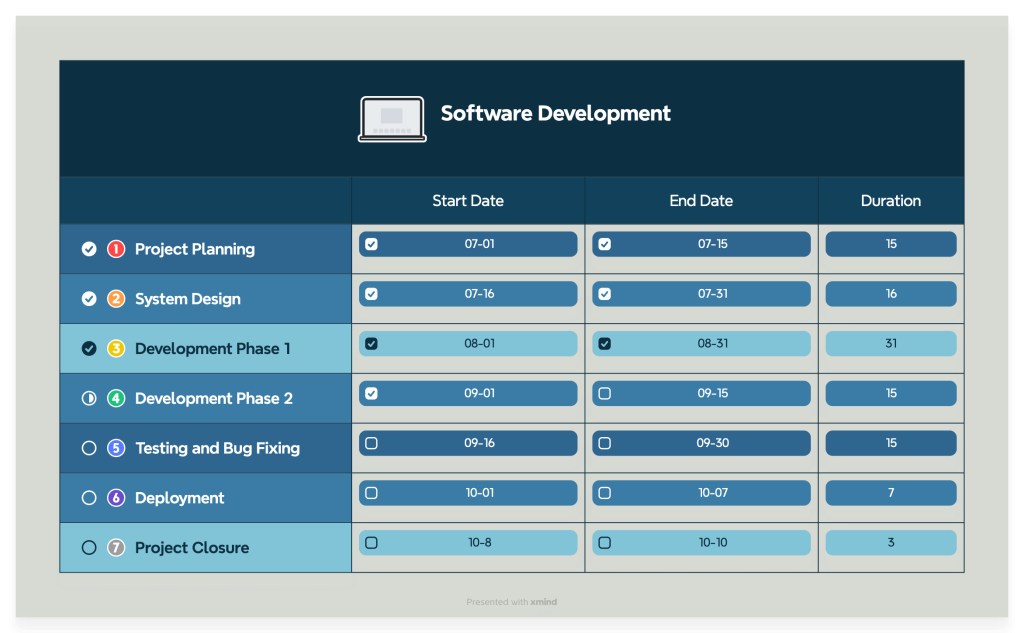Minimalism and Project Management: Techniques to Simplify Processes and Increase Results

Understanding Minimalism in Project Management
In an age where multitasking and constant connectivity dominate the workplace, the art of simplicity has never been more critical. Minimalism in project management serves as a refreshing approach that advocates for reduced clutter in tasks, communication, and processes. It encourages project managers to distill their methodologies down to the essentials, thereby enhancing overall productivity and team dynamics.
Simplifying communication is one of the hallmark principles of minimalism. For instance, instead of inundating team members with chains of emails, one could utilize concise project management tools like Slack or Asana. By consolidating discussions in easily accessible platforms, teams can achieve clarity without the noise that often accompanies traditional communication methods. This not only saves time but also minimizes misunderstandings, paving the way for more effective collaboration.
Moreover, streamlining processes can lead to significant productivity boosts. This might involve cutting down on unnecessary meetings or using templates for recurring reports. For example, if a project manager notices that weekly meetings often spiral into tangential discussions, they might implement a strict agenda or set a time limit, thus ensuring that the focus remains on actionable outcomes. Embracing simplicity can often reveal underlying inefficiencies that, when addressed, enhance workflow and project delivery.
In terms of enhancing focus, the minimalist approach places a premium on reducing distractions. Research indicates that professionals frequently jump between tasks, a behavior known as task-switching, which can decrease productivity by as much as 40%. By creating an environment that minimizes interruptions—like silencing notifications during critical work periods—teams are more likely to produce high-quality results.
It’s important to stress that minimalism does not equate to lower standards; rather, it champions the essentials that drive achievement. For instance, consider how industry giants such as Apple employ minimalist design principles. Their projects reflect an emphasis on quality, functionality, and user experience. The same can be said for IKEA, which keeps its product lines uncluttered while maintaining functional elegance. This approach translates excellently to project management, where the goal is to deliver outstanding outcomes efficiently.

As we explore minimalism in project management, it becomes clear that the adoption of these strategies can fundamentally transform the way teams operate. By implementing proven techniques aimed at reducing complexity, project managers can not only improve delivery timelines but also increase client satisfaction. In the ever-evolving landscape of project management, embracing minimalism may just be the key to unlocking unprecedented success.
DISCOVER MORE: Click here for expert tips
Key Techniques for Embracing Minimalism in Project Management
To fully harness the power of minimalism in project management, it is crucial to implement specific techniques that can simplify processes and amplify results. These techniques are designed to eliminate excess, enhance focus, and ultimately lead to more streamlined operations. Here are some essential strategies to consider:
1. Prioritize Essential Tasks
One of the foundational principles of minimalism is the emphasis on prioritization. Project managers should regularly evaluate tasks and focus on those that contribute the most significant value. By identifying and concentrating on high-impact goals, teams can channel their efforts toward activities that generate tangible results. Creating a priority matrix can aid in distinguishing between urgent and important tasks, ensuring that team resources are allocated effectively.
2. Utilize Visual Management Tools
Visual management tools, such as Kanban boards, offer a minimalistic means of tracking progress. These tools allow teams to visualize workflows and spot bottlenecks quickly, fostering transparency and accountability. When everyone can see the status of various tasks at a glance, communication tends to become more efficient.
Using color codes for different priority levels can further enhance clarity and encourage quick decision-making.
3. Standardize Processes
Standardizing processes is another effective technique to simplify project management. By developing templates for common tasks—such as reporting, documentation, and communication—project managers can reduce the time spent on administrative work and minimize variability in project delivery. This not only streamlines the work but also enhances the overall quality of outputs. Consider implementing templates that encapsulate best practices; over time, this may lead to fewer errors and higher consistency.
4. Foster a Culture of Feedback
Feedback is an essential component of any successful project management strategy. Embracing minimalism encourages open lines of communication and promotes a feedback-rich environment without overwhelming team members. Regularly scheduled check-ins can offer opportunities for constructive feedback while reducing the number of ad-hoc discussions that can cloud focus.
Additionally, tools like anonymous surveys or one-on-one discussions can help gather insights without adding to the noise.
5. Limit Project Scope
Another critical technique in achieving minimalism in project management is defining and limiting project scope. Often, projects encounter “scope creep” where new tasks and features are added over time, leading to complexity and confusion. By establishing clear boundaries from the outset, teams can focus on their primary objectives and avoid getting sidetracked by unnecessary additions. This can involve setting measurable goals and delivering value incrementally, ultimately yielding better overall outcomes.
- Prioritize essential tasks.
- Utilize visual management tools.
- Standardize processes.
- Foster a culture of feedback.
- Limit project scope.
As project managers explore these techniques, they will likely find that minimalism promotes not only improved project delivery but also better team morale, as work environments become less fraught with stress and confusion. Embracing minimalism goes beyond superficial changes; it can redefine how teams collaborate and execute projects, all while fostering a culture of simplicity and focus.
Minimalism in Project Management: Streamlining Success
In today’s fast-paced world, minimalism in project management serves as a powerful technique to enhance efficiency by removing unnecessary complexities. By focusing solely on essential tasks and resources, project managers can create a more effective workflow. Reducing clutter, both in physical workspaces and digital tools, enables teams to channel their energy toward high-impact activities, leading to improved results.
Implementing minimalist principles often starts with clear goal definitions. Establishing SMART (Specific, Measurable, Achievable, Relevant, Time-bound) goals helps teams maintain focus, eliminating distractions that do not align with the project’s core objectives. This clarity encourages collaboration and empowers employees to take ownership of their responsibilities, which ultimately strengthens teamwork.
Another prominent aspect of minimalism in project management is adopting streamlined communication practices. Simplifying communication channels—whether through project management software, direct messaging, or consistent feedback loops—facilitates quicker decision-making and enhances transparency. When communication is clear and direct, teams can tackle challenges swiftly and maintain momentum.
Tools that promote a minimalist approach, such as Kanban boards or Gantt charts, help visualize progress while keeping workload manageable. These tools emphasize simplicity while providing critical insights into the project lifecycle, ensuring that team members understand prioritization and deadlines at a glance. Through this visual representation, teams can avoid over-commitment and focus on delivering quality results.
Finally, adopting a culture of continuous improvement is essential in a minimalist project management framework. By encouraging teams to regularly reflect on processes and outcomes, organizations can identify areas for simplification and eliminate redundancies over time. This iterative approach not only enhances productivity but fosters an environment of innovation and adaptability.
| Category 1 | Category 2 |
|---|---|
| Efficiency | Removing unnecessary tasks allows teams to focus on high-value activities, driving progress forward. |
| Clarity | Establishing clear goals helps direct efforts toward essential outcomes, ensuring everyone is aligned and engaged. |
Incorporating minimalism into project management is not merely a trend; it is a fundamental shift that can yield sustainable results. As organizations seek to adapt to the complexities of modern workflows, embracing this philosophy can enhance overall performance and lead teams towards remarkable achievements.
DISCOVER MORE: Click here to enhance your understanding
Embracing Technology for Minimalism in Project Management
In today’s fast-paced digital landscape, technology can be a powerful ally in adopting minimalism within project management. By leveraging digital tools and solutions, project managers can not only streamline their processes but also enhance team collaboration and communication. Here are some compelling ways technology can support minimalist methodologies:
1. Implement Project Management Software
Using dedicated project management software can profoundly simplify workflows. Tools such as Trello, Asana, or Monday.com provide organizations with a digital platform to manage tasks efficiently. These tools often feature intuitive interfaces that allow teams to track progress, assign responsibilities, and set deadlines—all in one place. By organizing projects visually, teams can eliminate the need for endless email chains and unproductive meetings, allowing everyone to focus on their core tasks.
2. Automate Repetitive Tasks
Automation is a revolutionary aspect of minimalism in project management. Tasks that are repetitive in nature, such as status updates, email notifications, or document sharing, can be automated to save time and reduce human error. Utilizing tools such as Zapier or Automate.io can help create workflows that facilitate automatic data transfers between applications. This ensures that project managers and teams can devote more energy to strategic planning instead of menial tasks.
3. Adopt Cloud-Based Solutions
Cloud computing has changed the way teams collaborate and share information. By utilizing cloud-based solutions like Google Drive, Dropbox, or Microsoft OneDrive, project managers can enable seamless data sharing and editing from anywhere in the world. This not only boosts accessibility but also narrows down the need for physical storage, contributing to a minimalist approach. Furthermore, real-time collaboration can eradicate version control issues, ensuring all team members have the latest information at their fingertips.
4. Enhance Communication Channels
Effective communication is the backbone of successful project management. Embracing technology allows project managers to streamline communication through platforms such as Slack or Microsoft Teams. These tools provide focused discussion threads, reducing the chaos often caused by traditional email systems. By creating dedicated channels for specific projects or topics, teams can easily share ideas and updates without feeling overwhelmed by mixed messages.
5. Use Data Analytics for Informed Decisions
Minimalism thrives on making informed choices that drive results. Leveraging data analytics tools can help project managers interpret project performance metrics clearly. Tools like Tableau or Power BI allow for visual representation of data, making it easier to identify strengths and weaknesses in project execution. By focusing on key performance indicators (KPIs), project teams can swiftly pivot strategies and align their efforts with organizational goals.
- Implement project management software.
- Automate repetitive tasks.
- Adopt cloud-based solutions.
- Enhance communication channels.
- Use data analytics for informed decisions.
As technology continues to evolve, project managers who embrace these minimalist techniques are likely to see not only an increase in efficiency but also a rejuvenated workspace where creativity and productivity flourish. Minimalism in project management is about making deliberate choices; the integration of technology plays an essential role in facilitating those choices. Transitioning towards a more streamlined approach has the potential to foster a culture that values simplicity, efficiency, and innovation.
DISCOVER MORE: Click here to enhance your online experience
Conclusion
In a world where complexity often reigns supreme, adopting a minimalist approach to project management can be a game-changer for teams striving for efficiency and clarity. By focusing on the essentials—streamlining processes, leveraging technology, and enhancing communication—organizations can significantly boost productivity and drive better results. The integration of project management software, automation, and cloud-based solutions not only mitigates unnecessary clutter but also empowers teams to collaborate effectively from virtually anywhere.
Moreover, the emphasis on data analytics provides invaluable insights, enabling project managers to make informed decisions quickly and adapt strategies as needed. As we navigate the increasingly interconnected digital landscape, the value of a minimalist approach cannot be overstated; it fosters a culture of simplicity that encourages creative problem-solving and innovation.
Ultimately, minimalism in project management is not merely a trend, but a vital strategy for organizations aiming to thrive in a competitive environment. By embracing these techniques, businesses can cultivate not just improved outcomes, but also a more harmonious and productive workplace. In pursuing this pathway of simplification, project managers pave the way for a future where clarity reigns, collaboration flourishes, and results speak for themselves. As you consider the integration of minimalist practices into your own project management framework, remember: less is often more.


